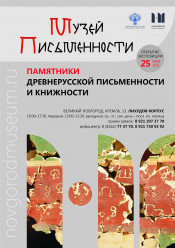
Marking Slavic Writing and Culture Day: Museum of Writing to open at the Likhud Block of the Novgorod Kremlin
On May 25, 2021, the Likhud Block of the Novgorod Kremlin will hold an opening of the Museum of Writing, a new object of the Novgorod Museum-Reserve. Its launch is timed to coincide with Slavic Writing and Culture Day. The exposition is located in the building where one of the first Russian higher education institutions worked at the beginning of the XVIII century. The building got its name after the first teachers of this school, the Greek monks - brothers Ioannikios and Sophronios Likhud. The exposition reveals the history of the development and spread of writing and literacy in Veliky Novgorod - the largest centre of chronicle writing, education and literacy of Ancient Rus'.
The Museum of Writing features about two hundred items from the collections of the Novgorod Museum-Reserve. It includes the oldest book of Ancient Rus' - The Novgorod Psalter (XI century); The Andreichina Gospel (1575), an outstanding example of the decorated manuscript book; The Anonymous Gospel (1563-1564), one of the first Russian printed books, published several years before the famous editions by Ivan Fyodorov. It also showcases the copies of Novgorod manuscripts from other collections (the State Historical Museum, the National Library of Russia and the Russian State Library). The exposition involves multimedia content: videos, interactive game programs, animated drawn books, which provide information about the first alphabet, counting systems used by ancient Novgorod residents, birch bark letters, the most ancient codes, their customers and contractors.
Novgorod's contribution to the spread of writing in Ancient Rus' is unique. The complex of Novgorod birch bark letters is of outstanding value for Russian and world culture. One third of the oldest Slavic and Old Russian books originates from Novgorod. The Museum of Writing presents the history of Old Russian books, demonstrates the art of calligraphy and book decoration, tells about the development of book printing in Russia and the fate of Novgorod libraries. It displays the inscriptions made by the ancient Novgorod residents on household things and items of applied art. The exposition comprises ancient Russian coins and seals, stone crosses and fragments of ancient graffiti with Cyrillic and Glagolitic inscriptions. A separate room is devoted to a unique phenomenon of ancient Russian medieval writing - birch bark letters. The final section highlights the history of the Likhud Brothers' School.
Another important theme of the project concerns the people who created written works - chroniclers, calligraphers, clerks, translators, artists, curators of the book heritage. The exposition evokes the names of the XI century writer Ghoul Likhoi; the first Russian mathematician Kirik; Archbishop Vasily Kalika, the author of the Poslaniye o Raje (Epistle about Paradise); the creator of the first Russian illustrated textbook Karion Istomin and his co-author, artist Leonty Bunin; the author of one of the first Russian grammars, director and teacher of the Likhud Brothers' School Fyodor Maksimov.
The Novgorod Museum-Reserve managed to launch a new museum thanks to the project of the Ministry of Culture of the Russian Federation "Preservation and Use of Cultural Heritage in Russia". It has been realizing since 2011 by the Saint-Petersburg Investment Projects Foundation financed by a government.

